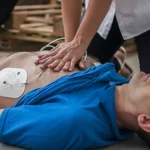Heat stroke, dehydration, and heat exhaustion are some of the most common heat illnesses. Understanding the differences between these conditions and how to apply treatment could mean the difference between life and death.
This blog discusses the differences between dehydration, heat stroke, and heat exhaustion first-aid. The American Health Care Academy aims to increase public awareness so bystanders can give higher-quality medical care during heat-related illness emergencies.
We are in a public health crisis. Less than half of Americans say they feel comfortable giving someone CPR in medical emergencies. Help fulfill your civic duty by getting CPR/AED/First-Aid certified today.
What Is Dehydration?
Dehydration occurs when your body loses more fluids than it retains. It happens more often in young children and older adults. For these age groups, minor illnesses such as infections, especially those affecting the kidneys and bladder, can result in dehydration.
What Are the Symptoms of Dehydration?
The symptoms of dehydration range according to different age groups.
Infant or Children-
- Sunken eyes, cheeks
- Sunken soft spot on top of the skull
- Listlessness or irritability
- No wet diaper for three hours
Adult
- Fatigue
- Dizziness
- Confusion
- Extreme thirst
- Less frequent urination
- Dark-colored urine
When to see a doctor
Call your family doctor if you or a loved one:
- Has had diarrhea for 24 hours or more
- Is irritable or disoriented and much sleepier or less active than usual
- Can’t keep down fluids
- Has bloody or black stool
Dehydration is a severe condition, and you should not take it lightly. In extreme cases, it can cause death.
What Is Heat Exhaustion?
Unlike heat stroke, heat exhaustion involves heavy sweating and a rapid pulse. Prolonged exposure to hot environments and performing strenuous activities in high humidity can cause the body to overheat and lead to dehydration and heat exhaustion.
Heat exhaustion is the precursor to heat stroke. However, it is preventable. It starts as heat cramps that can lead to heat stroke if not given proper treatment. It is also accompanied by dehydration and can cause nausea, vomiting, and muscle weakness.
You can gauge your risk for heat exhaustion by looking at the heat index and doing your best to stay hydrated. Even mild dehydration can lead to heat exhaustion, depending on the heat index. Remember, heat exhaustion and heat stroke are related to high body temperature, not only dehydration.
What Are the Symptoms of Heat Exhaustion?
The signs of heat exhaustion include:
- Cool, moist skin with goosebumps when in heat
- Heavy sweating
- Faintness
- Dizziness
- Fatigue
- Weak, rapid pulse
- Low blood pressure upon standing
- Muscle cramps
- Nausea
- Headache
During hot weather, the human body cools itself through sweat, which regulates body temperature. But high-temperature environments can prohibit the body from cooling itself, leading to heat exhaustion. Other contributing factors such as strenuous physical activity and dehydration can contribute to heat exhaustion.
The difference between heat stroke and heat exhaustion is that the body’s temperature reaches over 103 degrees in heat stroke cases. Both conditions cause similar symptoms such as body cramps, sudden, excessive sweating, nausea, and fainting.
What Is Heat Stroke?
Heat stroke is a form of hyperthermia, and it occurs when someone’s body temperature rapidly increases (body overheating). Heat stroke victims’ body temperatures rise to 40°C (103°F) when they have prolonged exposure to high-temperature environments. Heat stroke can be fatal, especially if the victim doesn’t receive medical attention right away.
Heat stroke is often accompanied by dehydration as someone’s body temperature increases and causes neurologic dysfunction. It is considered the most severe among the three heat-related syndromes.
What Are the Symptoms of Heat Stroke?
The symptoms of heat stroke include:
- Throbbing headache
- Dizziness and light-headedness
- Lack of sweating
- Red, hot, and dry skin
- Muscle weakness and cramps
- Nausea and vomiting
- Rapid heartbeat
- Rapid, shallow breathing
- Confusion, disorientation, or staggering
- Seizures
- Unconsciousness
There are two types of heat stroke:
- Exertional heat stroke (EHS) – EHS is experienced by individuals with prolonged exposure to heat and prolonged strenuous physical activities in high-temperature environments.
- Non-exertional heat stroke (NEHS) – occurs commonly in desk-bound, old-age individuals. non-exertional heat stroke occurs when no strenuous activities accompany the high-temperature environment.
Both heat stroke types are potentially fatal. They require immediate medical attention.
First-Aid For Dehydration and Heat Exhaustion
Heat exhaustion and heat stroke are caused by the body overheating and prolonged exposure to environments with high temperatures associated with dehydration. However, despite the same root, heat stroke and heat exhaustion show different signs and symptoms.
Hence, why the different conditions require different treatment methods. First-Aid for heat exhaustion and dehydration diseases includes:
- Move the person from the hot environment and get them into a cool environment.
- Have the victim drink plenty of fluids and avoiding caffeine and alcohol.
- Removing tight and unnecessary clothing.
- Taking a cool shower or bath to cool down the body temperature.
- Using other cooling measures like fans and ice towels.
- Replenish lost fluids
If you notice someone exhibiting dehydration or heat exhaustion signs, you should treat them. If their symptoms don’t improve, you should contact 911 and let EMT treatment for heat exhaustion take over.
Heat Stroke First-Aid
Heat stroke requires immediate professional medical attention. If you suspect someone has heat stroke, you should call 911. Before emergency medical professionals arrive, you should perform the following steps for treatment:
- Place in a tub of cool water or a cool shower.
- Spray with a garden hose.
- Sponge with cool water.
- Fan while misting with cool water.
- Place ice packs or cool, wet towels on the neck, armpits, and groin.
- Cover with cool, damp sheets.
If the person loses consciousness during a heat stroke, you should begin CPR. Consider taking first aid certification to be always prepared.
Conclusion- The Difference Between Heat Stroke, Dehydration, and Heat Exhaustion First-Aid
If you notice signs of heat-related illness, you should know when to use CPR or First-Aid techniques. The differences between these two could have an impact on the patient’s outcome.
The American Health Care Academy is here for all of your CPR and First Aid certification needs. Our affordable online classes can help you understand the difference between heat stroke and heat exhaustion. Contact us today and learn how you can get your CPR First Aid certification.













